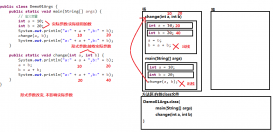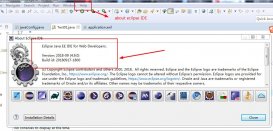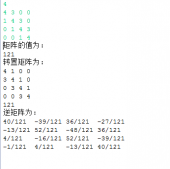Java8 自定义CompletableFuture原理
Future 接口 的局限性有很多,其中一个就是需要主动的去询问是否完成,如果等子线程的任务完成以后,通知我,那岂不是更好?
|
1
2
3
4
5
6
7
8
9
10
11
12
13
14
15
16
17
18
19
20
21
22
23
24
25
26
27
28
29
30
31
32
33
34
35
36
37
38
39
40
41
42
43
44
45
46
47
48
49
50
51
52
53
54
55
56
57
58
59
60
61
62
63
64
65
66
67
68
69
70
71
72
73
74
75
76
77
78
79
80
|
public class FutureInAction3 { public static void main(String[] args) { Future<String> future = invoke(() -> { try { Thread.sleep(10000L); return "I am Finished."; } catch (InterruptedException e) { return "I am Error"; } }); future.setCompletable(new Completable<String>() { @Override public void complete(String s) { System.out.println("complete called ---- " + s); } @Override public void exception(Throwable cause) { System.out.println("error"); cause.printStackTrace(); } }); System.out.println("....do something else ....."); System.out.println("try to get result ->" + future.get()); } private static <T> Future<T> invoke(Callable<T> callable) { AtomicReference<T> result = new AtomicReference<>(); AtomicBoolean finished = new AtomicBoolean(false); Future<T> future = new Future<T>() { private Completable<T> completable; @Override public T get() { return result.get(); } @Override public boolean isDone() { return finished.get(); } // 设置完成 @Override public void setCompletable(Completable<T> completable) { this.completable = completable; } // 获取 @Override public Completable<T> getCompletable() { return completable; } }; Thread t = new Thread(() -> { try { T value = callable.action(); result.set(value); finished.set(true); if (future.getCompletable() != null) future.getCompletable().complete(value); } catch (Throwable cause) { if (future.getCompletable() != null) future.getCompletable().exception(cause); } }); t.start(); return future; } private interface Future<T> { T get(); boolean isDone(); // 1 void setCompletable(Completable<T> completable); // 2 Completable<T> getCompletable(); } private interface Callable<T> { T action(); } // 回调接口 private interface Completable<T> { void complete(T t); void exception(Throwable cause); }} |

CompleteFuture简单使用
Java8 中的 completeFuture 是对 Future 的扩展实现, 主要是为了弥补 Future 没有相应的回调机制的缺陷.
我们先看看 Java8 之前的 Future 的使用
|
1
2
3
4
5
6
7
8
9
10
11
12
13
14
15
16
17
18
19
20
21
22
23
24
25
26
27
28
29
30
31
32
33
34
35
36
37
38
39
40
41
42
43
|
package demos;import java.util.concurrent.ExecutionException;import java.util.concurrent.ExecutorService;import java.util.concurrent.Executors;import java.util.concurrent.Future;/** * @author djh on 2019/4/22 10:23 * @E-Mail 1544579459@qq.com */public class Demo { public static void main(String[] args) throws ExecutionException, InterruptedException { ExecutorService cachePool = Executors.newCachedThreadPool(); Future<String> future = cachePool.submit(() -> { Thread.sleep(3000); return "异步任务计算结果!"; }); // 提交完异步任务后, 主线程可以继续干一些其他的事情. doSomeThingElse(); // 为了获取异步计算结果, 我们可以通过 future.get 和 轮询机制来获取. String result; // Get 方式会导致当前线程阻塞, 这显然违背了异步计算的初衷. // result = future.get(); // 轮询方式虽然不会导致当前线程阻塞, 但是会导致高额的 CPU 负载. long start = System.currentTimeMillis(); while (true) { if (future.isDone()) { break; } } System.out.println("轮询耗时:" + (System.currentTimeMillis() - start)); result = future.get(); System.out.println("获取到异步计算结果啦: " + result); cachePool.shutdown(); } private static void doSomeThingElse() { try { Thread.sleep(1000); } catch (InterruptedException e) { e.printStackTrace(); } System.out.println("我的最重要的事情干完了, 我要获取异步计算结果来执行剩下的事情."); }} |
输出:
我的最重要的事情干完了, 我要获取异步计算结果来执行剩下的事情.
轮询耗时:2000
获取到异步计算结果啦: 异步任务计算结果!Process finished with exit code 0
从上面的 Demo 中我们可以看出, future 在执行异步任务时, 对于结果的获取显的不那么优雅, 很多第三方库就针对 Future 提供了回调式的接口以用来获取异步计算结果, 如Google的: ListenableFuture, 而 Java8 所提供的 CompleteFuture 便是官方为了弥补这方面的不足而提供的 API.
下面简单介绍用法
|
1
2
3
4
5
6
7
8
9
10
11
12
13
14
15
16
17
18
19
20
21
22
23
24
25
26
27
28
29
30
31
32
33
34
35
36
37
38
39
40
|
package demos;import java.util.concurrent.CompletableFuture;import java.util.concurrent.ExecutionException;import java.util.concurrent.ExecutorService;import java.util.concurrent.Executors;/** * @author djh on 2019/5/1 20:26 * @E-Mail 1544579459@qq.com */public class CompleteFutureDemo { public static void main(String[] args) throws ExecutionException, InterruptedException { CompletableFuture<String> completableFutureOne = new CompletableFuture<>(); ExecutorService cachePool = Executors.newCachedThreadPool(); cachePool.execute(() -> { try { Thread.sleep(3000); completableFutureOne.complete("异步任务执行结果"); System.out.println(Thread.currentThread().getName()); } catch (InterruptedException e) { e.printStackTrace(); } }); // WhenComplete 方法返回的 CompletableFuture 仍然是原来的 CompletableFuture 计算结果. CompletableFuture<String> completableFutureTwo = completableFutureOne.whenComplete((s, throwable) -> { System.out.println("当异步任务执行完毕时打印异步任务的执行结果: " + s); }); // ThenApply 方法返回的是一个新的 completeFuture. CompletableFuture<Integer> completableFutureThree = completableFutureTwo.thenApply(s -> { System.out.println("当异步任务执行结束时, 根据上一次的异步任务结果, 继续开始一个新的异步任务!"); try { Thread.sleep(1000); } catch (InterruptedException e) { e.printStackTrace(); } return s.length(); }); System.out.println("阻塞方式获取执行结果:" + completableFutureThree.get()); cachePool.shutdown(); }} |
从上面的 Demo 中我们主要需要注意 thenApply 和 whenComplete 这两个方法, 这两个方法便是 CompleteFuture 中最具有意义的方法, 他们都会在 completeFuture 调用 complete 方法传入异步计算结果时回调, 从而获取到异步任务的结果.
相比之下 future 的阻塞和轮询方式获取异步任务的计算结果, CompleteFuture 获取结果的方式就显的优雅的多。
以上为个人经验,希望能给大家一个参考,也希望大家多多支持服务器之家。
原文链接:https://artisan.blog.csdn.net/article/details/115450097














